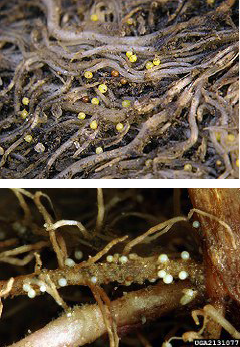Nematode juveniles and adults resemble worms, earning them the common name "roundworms." They have six life stages: egg, four juvenile stages, and adult. Most species have both male and female adult forms, and reproduce sexually. Potato cyst nematodes in the genus Globodera are obligate parasites of several solanaceous plant hosts. Globodera are among the most challenging plant pests to control, because the "cyst" is actually the body of a dead female nematode containing hundreds of eggs. Cysts with viable eggs can persist in soil for decades, where they remain relatively resistant to chemical and biological stresses, until eggs are stimulated to hatch by root exudates from susceptible plant hosts such as potato. For that reason, movement of soil containing cysts (such as residual soil on harvested plant parts, or on farm equipment) is typically how these nematodes move from one field or geographic location to another. Eggs in cysts can remain viable for many years in the absence of solanaceous hosts. When eggs hatch, the second-stage juveniles emerge and swim short distances to host plant roots, where they penetrate, feed, and complete their life cycle. Extensive nematode feeding saps plant nutrients and can result in greatly reduced crop yields. Potato tubers themselves are not attacked. Left uncontrolled, over time nematode populations can increase dramatically in a potato field.

